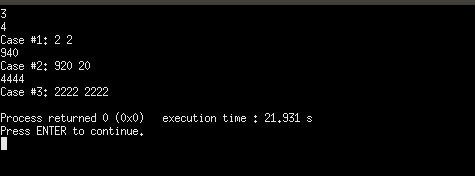Google CodeJam 2019 | Foregone Solution
Someone just won the Code Jam lottery, and we owe them N jamcoins! However, when we tried to print out an oversized check, we encountered a problem. The value of N, which is an integer, includes at least one digit that is a 4... and the 4 key on the keyboard of our oversized check printer is broken.
Fortunately, we have a workaround: we will send our winner two checks for positive integer amounts A and B, such that neither A nor B contains any digit that is a 4, and A + B = N. Please help us find any pair of values A and B that satisfy these conditions.
Input
The first line of the input gives the number of test cases, T. T test cases follow; each consists of one line with an integer N.
Output
For each test case, output one line containing Case #x: A B, where x is the test case number (starting from 1), and A and B are positive integers as described above.
It is guaranteed that at least one solution exists. If there are multiple solutions, you may output any one of them.
Sample
| Input |
Output |
3
4940
4444 |
Case #1: 2 2
Case #2: 852 88
Case #3: 667 3777 |
Reference: Foregone Solution
Explanation:
In Sample Case #1, notice that A and B can be the same. The only other possible answers are 1 3 and 3 1.
Note: Before going to solution, please try it by yourself.
Short description of solution approach
For any number N, let say, 45234, we can write it as 45234 + 00000 that is N = A+B, where A = 45234 and B = 00000. But, according to given condition there should not be any '4' in A or B. So, whenever we encounter '4' in A we can write it as 2 and at the same position at B we can put 2.
Example:
Input: 45234
Step 1:
45234 ← A
+00000 ← B
--------------------------------
45234 ← N
---------------------------------
Step 2:
25232 ← A
+20002 ← B
--------------------------
45234 ← N
---------------------------
Algorithm
Step1: Take input N (as a string) Step2: Take an array B of size N and initialize all values to 0 Step3: for(i=0;i<N.length();i++) Step3.1: if(N[i]=='4') B[i]='2'; N[i]=2; Step4: print N (that is A) and BExplanation
Please read "Short description of sloution approach" section given above.
C++ implementation:
Output

need an explanation for this answer? contact us directly to get an explanation for this answer